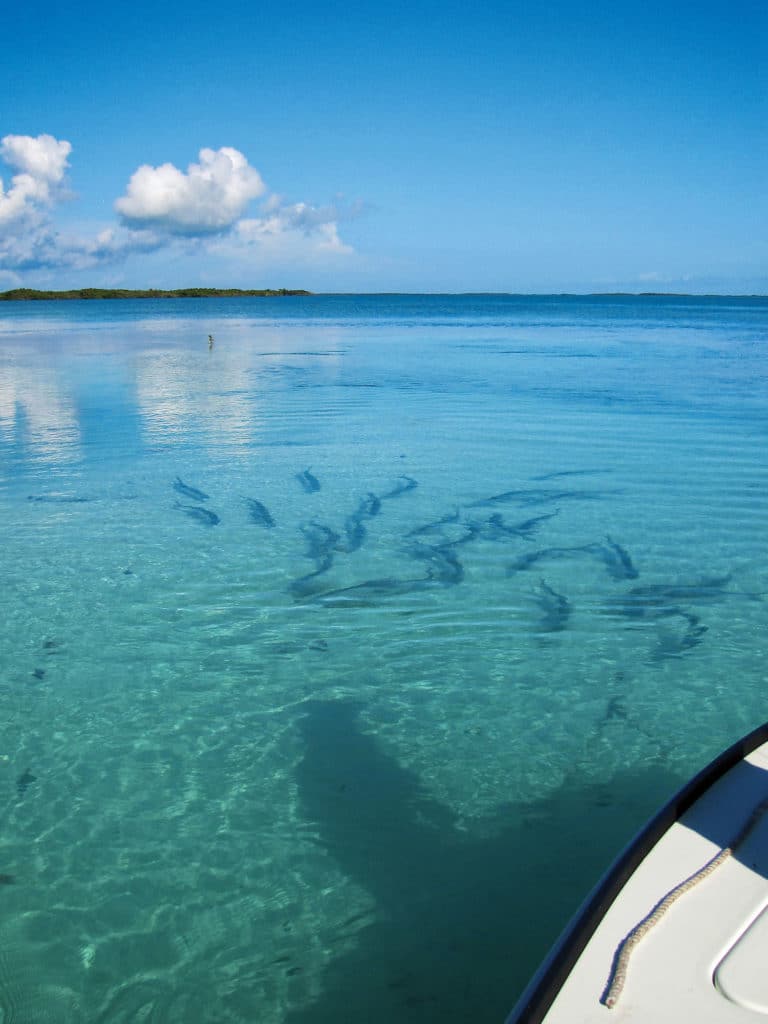
Our guide shut off the motor and barely had time to climb atop the poling platform when he announced, “Sábalo, sábalo!” And as if conjured by magic, a school of tarpon materialized 75 feet off the bow. We couldn’t ask for a better welcoming committee.
By the time I made the cast, a dozen 15-pounders cruised in unison a scant 50 feet from the boat. The leaders shifted right, and the rest of the school followed. My next delivery put the purple Tarpon Toad in the new path of the chrome targets, and a few strips were enough to coax two to pull away from the pack and race each other to the fly.
The winner gulped and turned, a classic move ingrained in every tarpon’s DNA. My strip strike drove the hook home, and the fish exploded into the air in wild contortions. It was only 10 a.m. and, having released several bonefish earlier, I couldn’t help but wonder: Could a flats grand slam in Cuba’s Ciénaga de Zapata be in the cards?
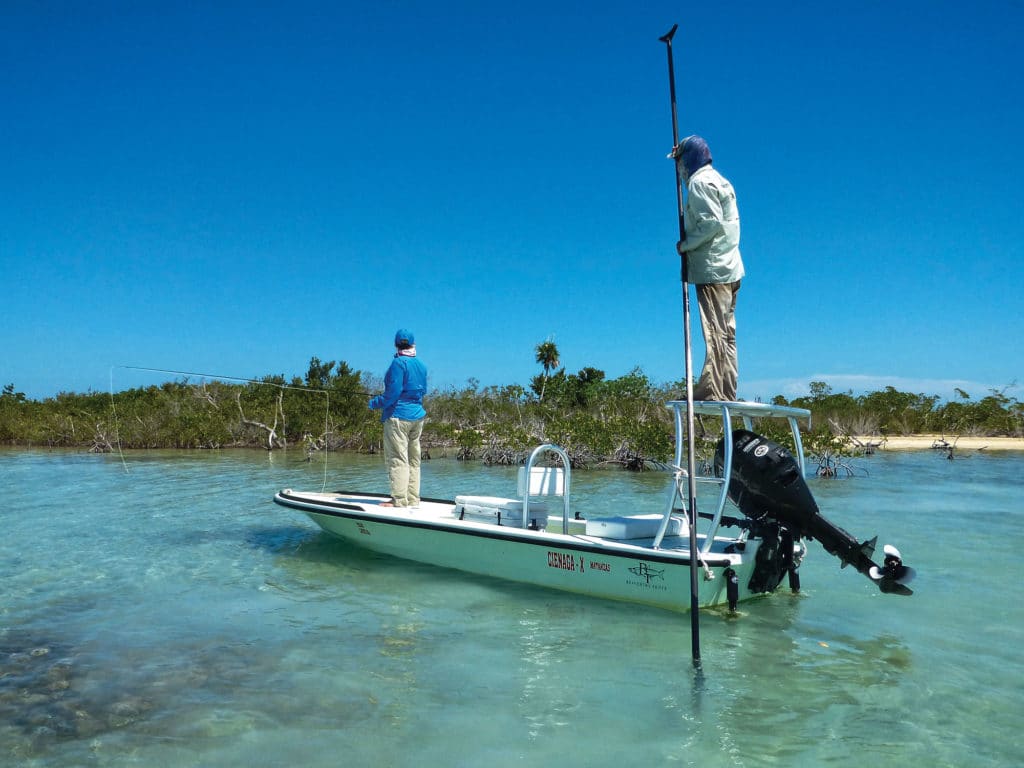
THREE IN ONE
We were met at the airport in Havana by Pedro Barrio, Enridan Fishing Tours’ diligent manager, who drove my wife Mary and me two and a half hours southeast to Playa Larga, a small town with immediate access to the fishing in the national park, which includes three distinct zones: Las Salinas, San Lázaro and Rio Hatiguanico. A maximum of 10 anglers are allowed daily in the first two, only four in the river, and all anglers must be accompanied by one of the guides, all of whom are employees of the national park.
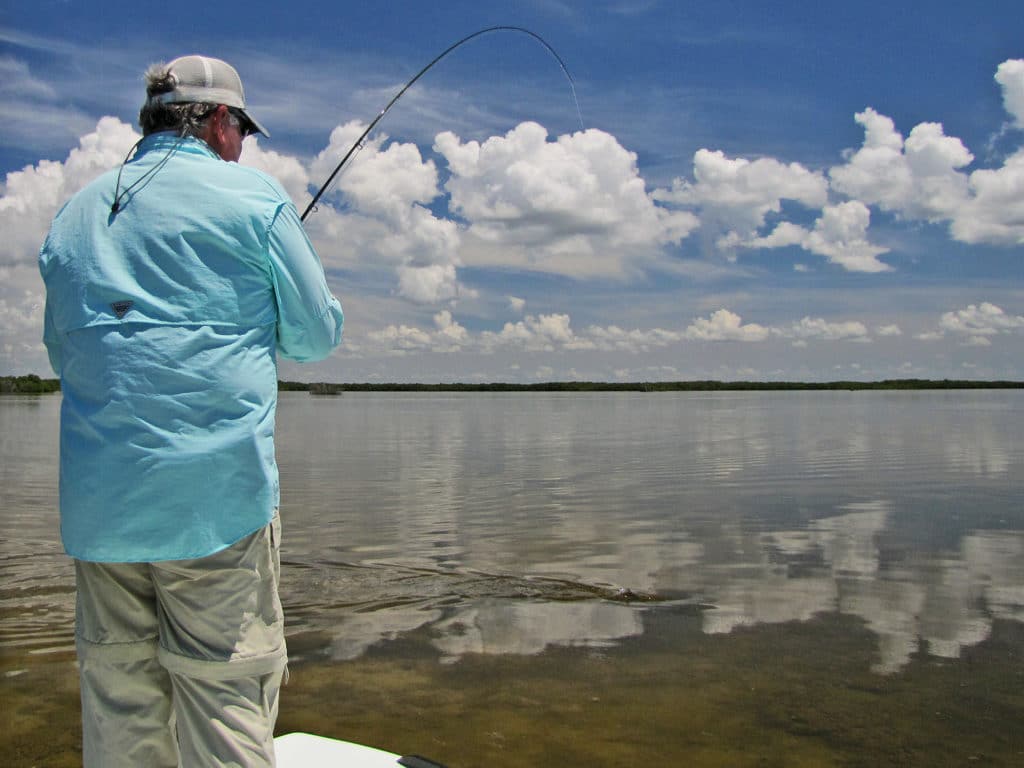
LAS SALINAS
Zigzagging to miss the battalions of stocky land crabs occupying the narrow road, we made the 14-mile trek from Playa Larga to a government outpost that houses guides and service staff. Out front, a fleet of flats skiffs floated under a covered dock, ready for action.
Still in awe of the flamingos, roseate spoonbills and countless other birds along the way, we assembled our gear, hopped in the boat and were off to look for fish. The area looked like a larger version of the Marls in Abaco, Bahamas: interconnected bays with light bottom and waist-high mangrove shorelines. We soon came upon a pack of small gray ghosts. I fed them a fly and scored my first Cuban bonefish. To our surprise, however, it took a while to find the next bunch, and later we discovered bones mudding in 4 feet of water in large groups.
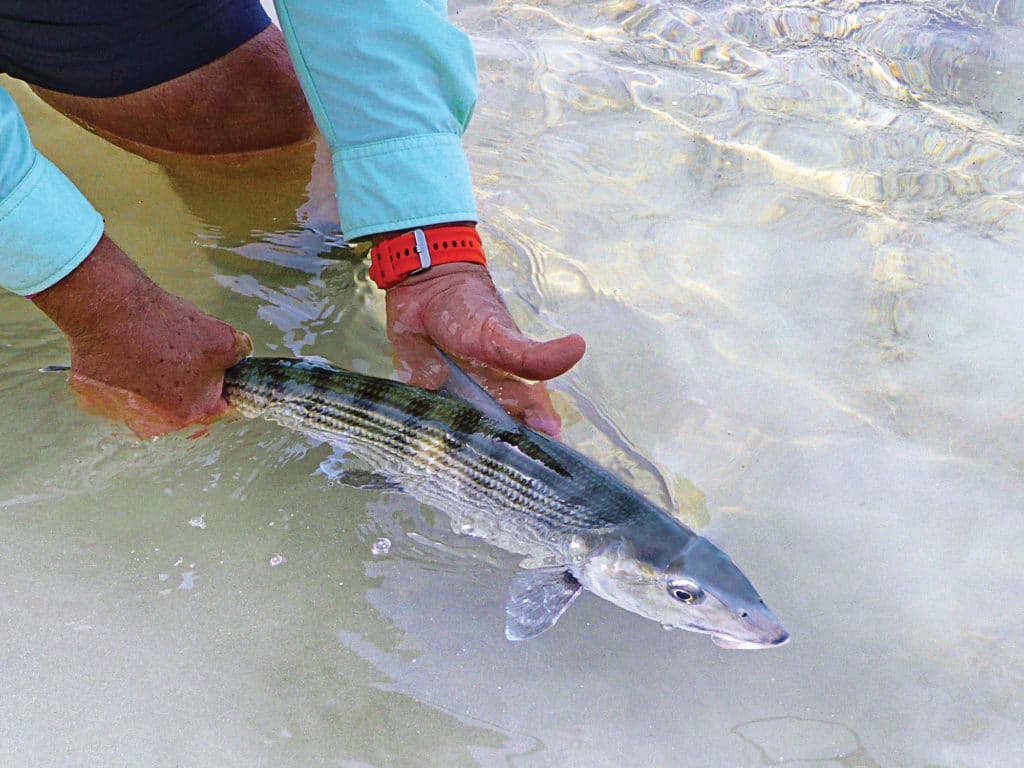
Milky patches of silt the size of a baseball diamond betrayed the foraging bonefish. I plucked several 2-pounders from different schools before I finally stuck one that sped away with some of my backing. My reel handle was a blur — this fish was bigger. But after a close call with a lemon shark, a silvery 4-pounder was in my grasp, posing for a snapshot.
Despite the healthy ecosystem (clean water, sea grass and abundant marine life), the bonefishing was sporadic the first day, perhaps because we opted to search for larger specimens in skinny water. But any reservations we may have had quickly dissipated with a change of location.
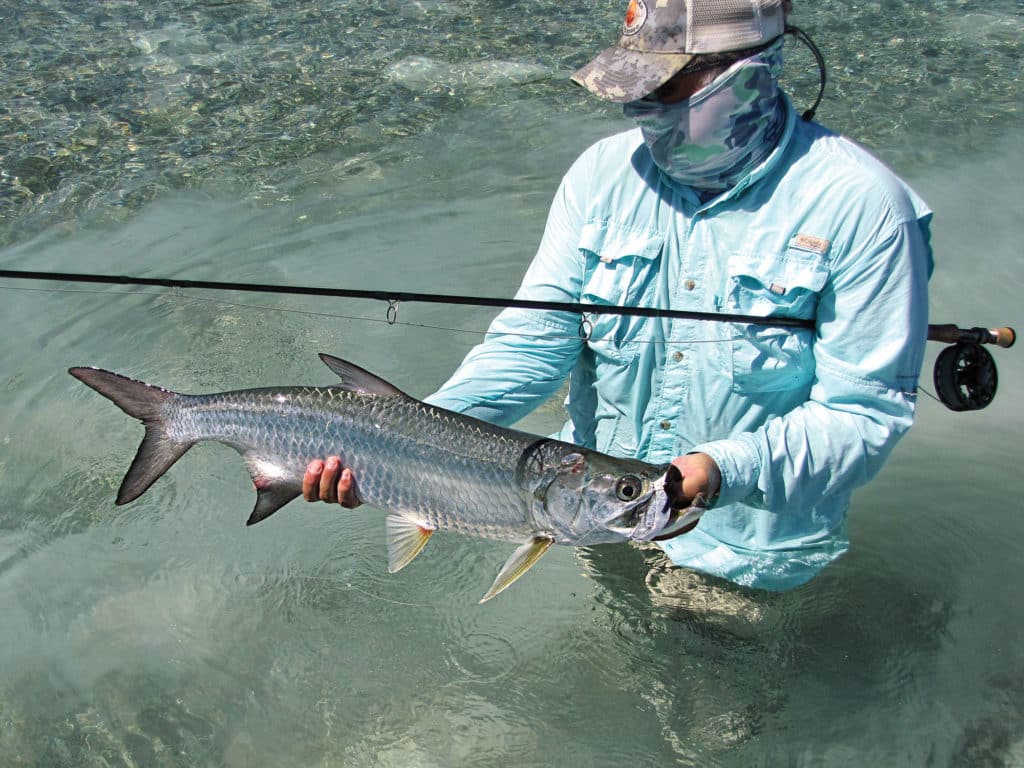
THE BOCAS
With the tide rising, we headed to the bocas, inlets where the open ocean meets the flats. Lazaro explained that permit and snapper come here looking for crabs and other morsels. I was about to trade my 8-weight rod for the 9-weight when he yelled, “Pargo!” A mutton snapper was milling around on the edge of a channel. There was no time to change, so I cast the size 4 Ragin’ Craven I’d used for the bones and hoped for the best.
As it often happens, a smaller fish beat the larger one to the fly. This time, at least, the smaller fish was another mutton, soon released after a brief tug of war. Urged by Lázaro, I made a few casts into the adjacent channel, letting the fly sink before stripping it back fast. My efforts were rewarded with another small mutton that a 40-pound cubera tried to eat and a much nicer one that came unbuttoned after an exciting 10-minute struggle.
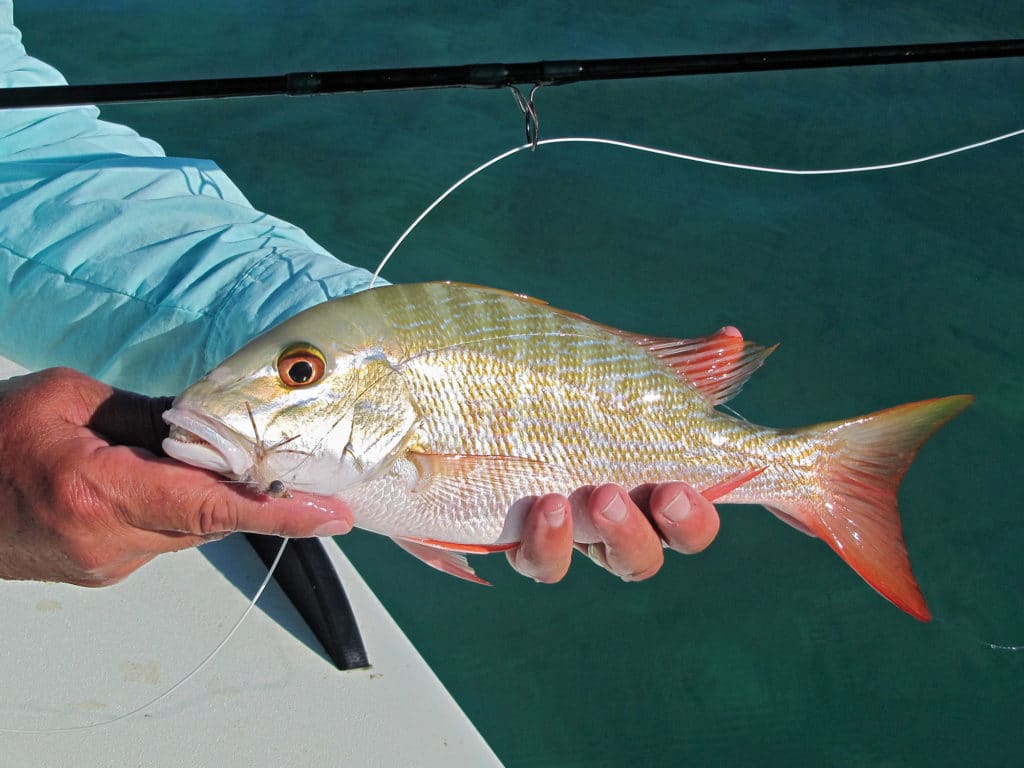
TARPON TIME
A nearby cluster of mangrove islands was next on the agenda. We’d just come off plane and were coasting toward the first shoreline when several juvenile tarpon rolled. Poling as quickly as he could, Lázaro gave chase, pushing the skiff into a narrow tidal lagoon where some 75 silver princes were not very happy to see us.
Amazingly, a few minutes’ wait was enough for the fish to settle down. The big school then broke into packs, which took turns swimming back and forth along the edge of the mangroves, and my 9-weight got a workout as we fought fun-size tarpon for a bit.
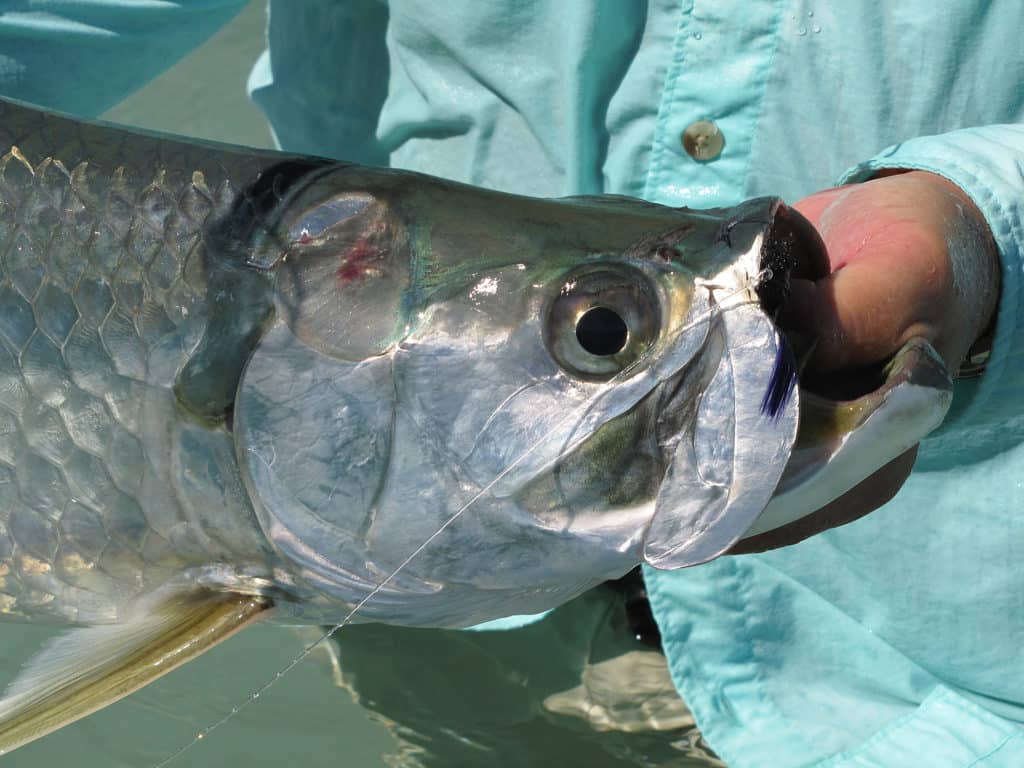
SAN LAZARO
After lunch, a 20-minute run brought us to San Lázaro. Despite adjoining Las Salinas, the water here was more tannic, the bottom rockier, and the grass short and sparse. Best of all, bonefish tailed everywhere, many larger than we’d seen previously and also more skittish. Yet the couple of hours we devoted yielded nine hookups and six fish boated — two in the 5- to 6-pound class.
It’s hard to leave so many tailers, but San Lázaro is home to trophy snook, and we couldn’t pass up that opportunity. There was no time to regret the move anyway, because the moment I put on the right leader and fly, our guide had us lie down to pull and push our way under mangroves into a series of tight lagoons.
While no stranger to dodging roots and branches to find fish in the backcountry, I’d never seen so many big snook and cuberas lurking in 18 inches of water. Many retreated slowly to the nearest mangroves as we approached, allowing us to get in a few casts before they reached safe haven. Several whopper linesiders snubbed me, but my insistence with a particular 10-pounder paid off. As I twitched the fly inches from its nose, the snook opened wide and ate.
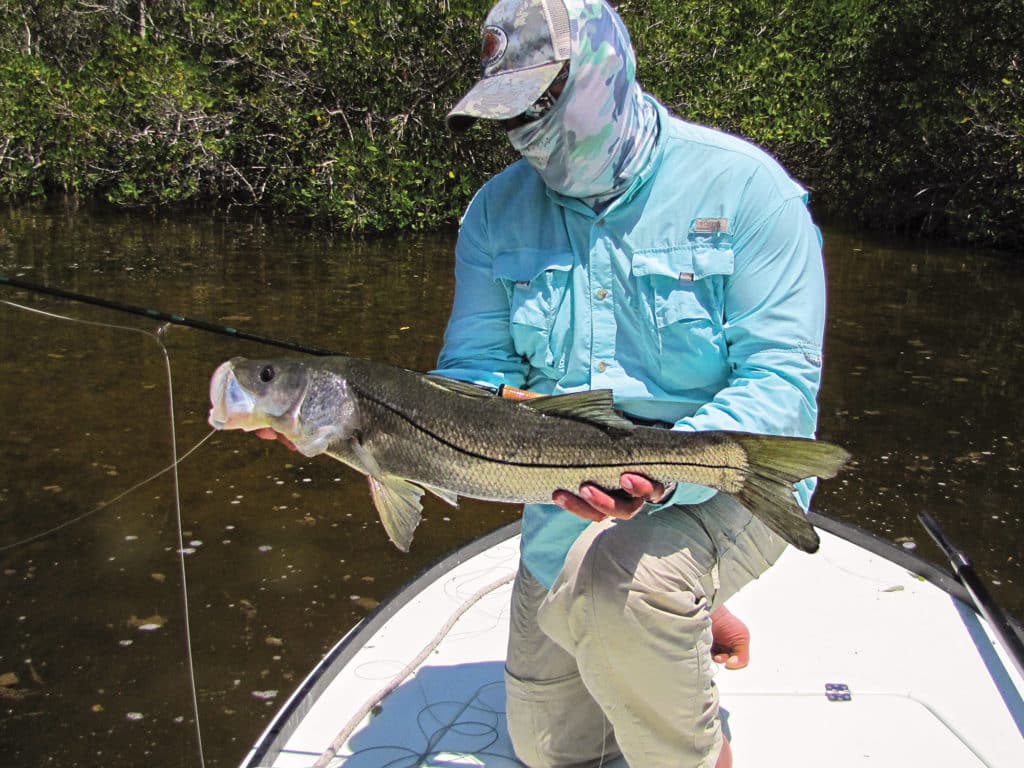
RIO HATIGUANICO
Though we didn’t come across any big tarpon in Las Salinas or San Lázaro, Hatiguanico, a spring-fed coastal river with stretches as deep as 30 feet, offered shots at 60- to 100-pounders, requiring long casts with weighted flies and fast-sinking lines.
If probing the depths in the vicinity of rollers isn’t your bag, juvenile tarpon often feast on minnows near the surface in various narrow fingers. My wife jumped a half-dozen during a couple of flurries, including a 20-pound beauty that slipped out of the guide’s grip during the landing.
Still recovering from a near miss with a snook just as big that inspected my fly twice before sinking out of sight for good, I cheered Mary on and recorded most of her battle. For a preview of the river tarpon action go to: saltwatersportsman.com/hatiguanicoriver.
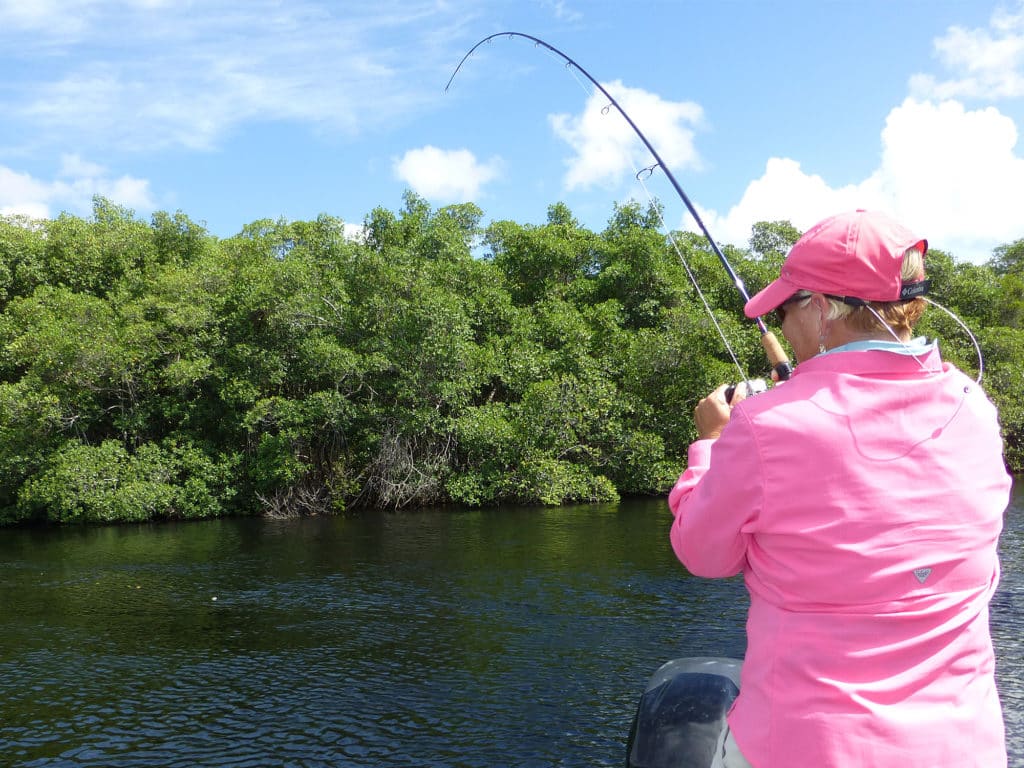
All said and done, Enridan and Ciénaga de Zapata surpassed our lofty expectations. No, I didn’t catch a permit, but as our guide said, bonefish, tarpon, snook and mutton snapper in one day is still a slam of a different flavor.
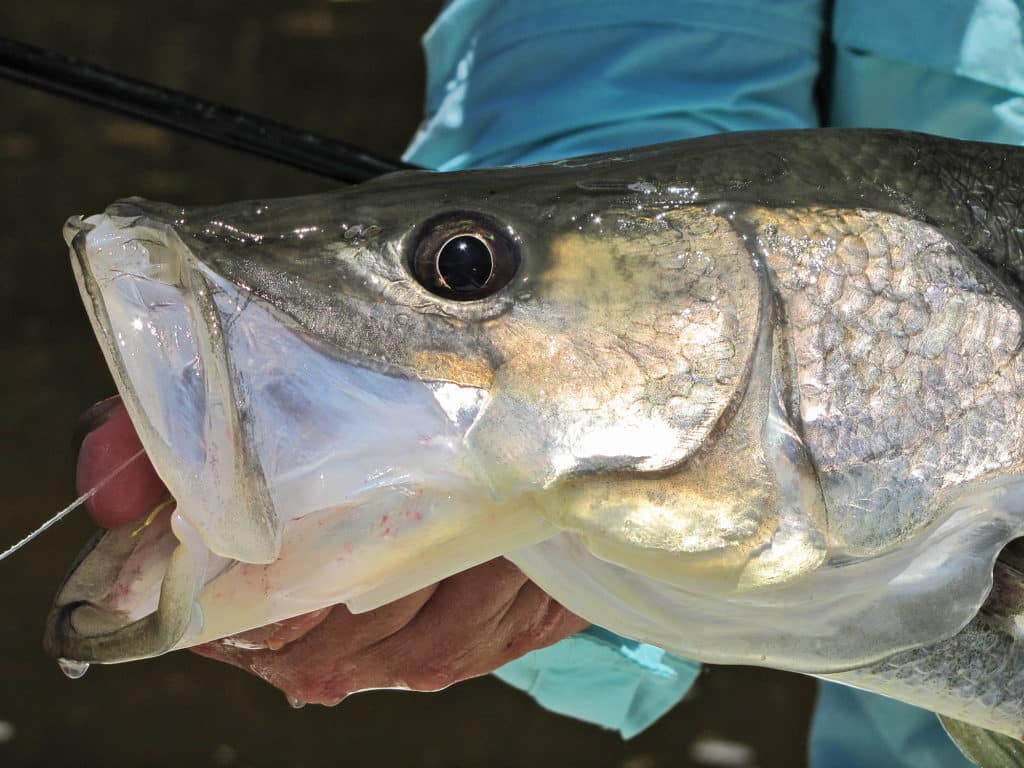
ENRIDAN FISHING TOURS
As part of Enridan’s fishing package, anglers stay at Hotel Horizontes Playa Larga on the shores of the famous Bahia de Cochinos (Bay of Pigs). Accommodations are spartan but clean, comfortable and private, and meals are included. The boats are new 16- and 17-foot Beavertail skiffs with poling platforms and Suzuki outboards (30 and 60 hp respectively). We had the pleasure of fishing with Felipe Rodriguez and Lázaro Viñola, both fluent in English, well-versed in the area’s cultural and natural histories, and with excellent knowledge of fly-fishing techniques and conservation acquired over two decades of guiding. They have collaborated with Bonefish and Tarpon Trust in studies and tagging efforts.
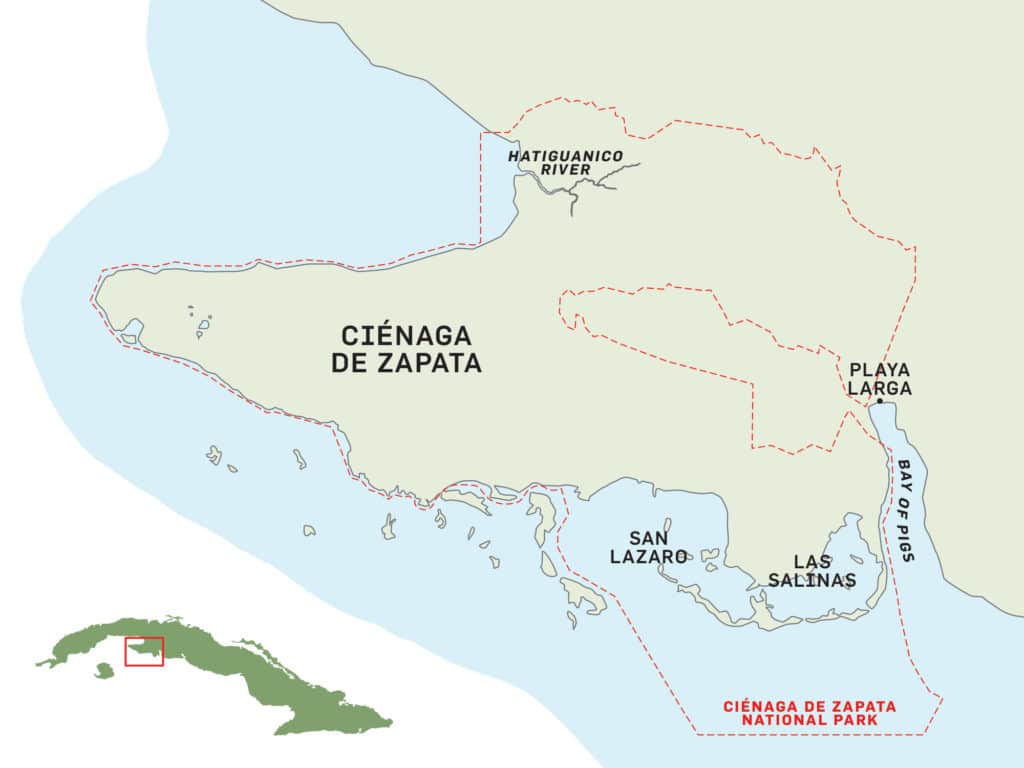
The national park is home to 31 types of reptiles (including the Cuban crocodile), plus some 175 resident species of birds, and 65 seasonal migrants. Enridan has exclusive rights to operate sport-fishing charters in a vast portion of the national park that includes Las Salinas, part of San Lázaro, and Rio Hatiguanico.
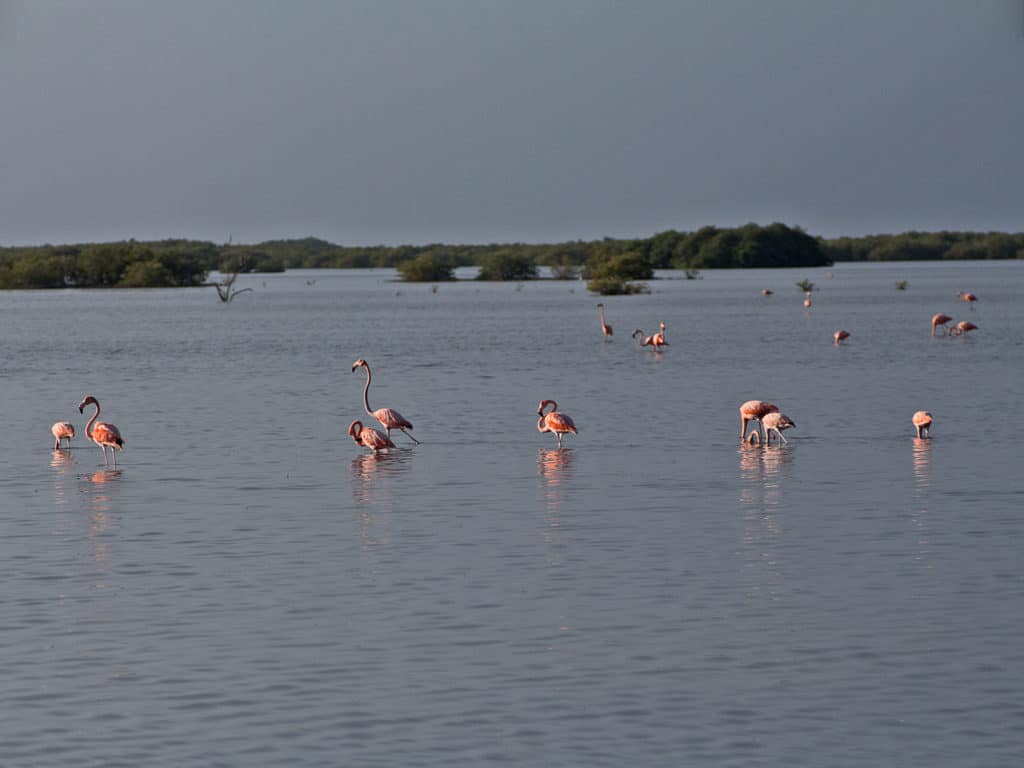
SWS PLANNER
Zapata Peninsula, Cuba
What: Bonefish, tarpon, snook, permit and snapper
Where: Ciénaga de Zapata National Park, Cuba
When: Year-round
Who: Travel to Cuba strictly for tourism is forbidden. Anglers must fish under the auspices of ongoing fisheries research programs, which is arranged through established tour operators.
Take Me Away Travel 786-483-8663 takemeawaycuba .com
Yellow Dog Fly Fishing Adventures 406-585-8667 yellowdogflyfishing.com
Trek International Safaris 800-654-9915 treksafaris.com
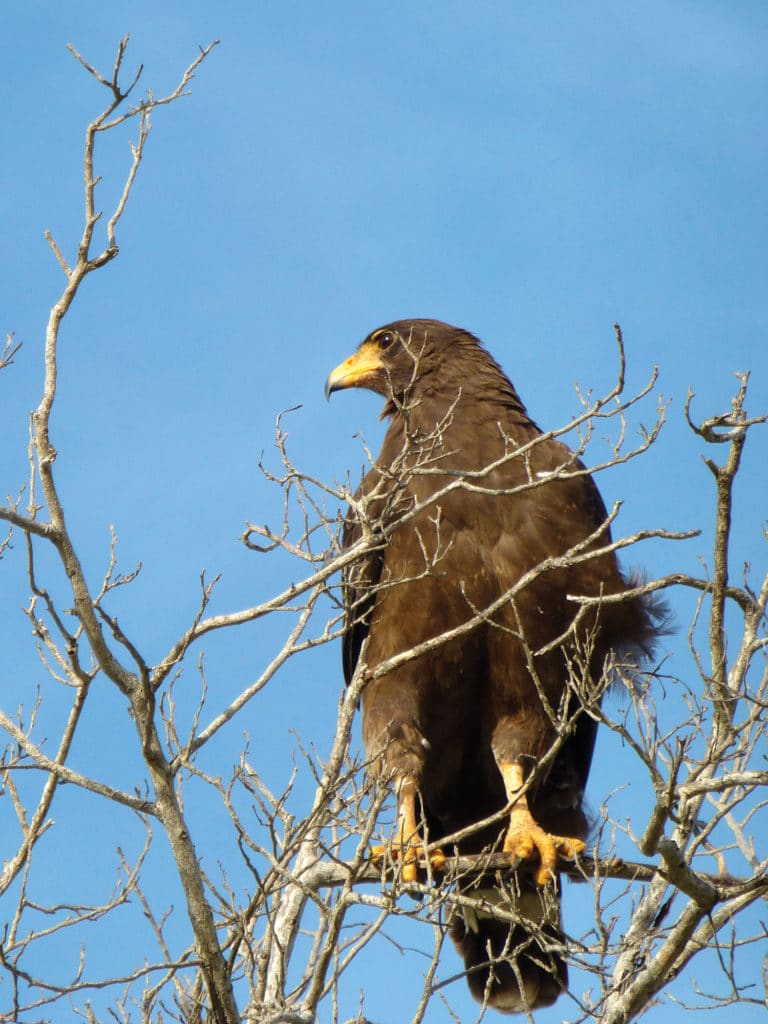
SWS TACKLE BOX
Zapata Peninsula, Cuba
National park regulations stipulate fly-fishing only, but the limited number of anglers allowed, sound conservation practices, and productive waters with lightly pressured fish ensure even less-experienced fly-rodders a high probability of success.
Rods: 9-foot, fast-action 7- or 8-weight for bonefish, 9-weight for snook, small tarpon, permit and muttons, 10- to 12-weight for larger tarpon (Temple Fork Outfitters’ BVK or equivalent)
Reels: Sized to match rods, with large arbors and capacity for 200 yards of backing (more for big tarpon)
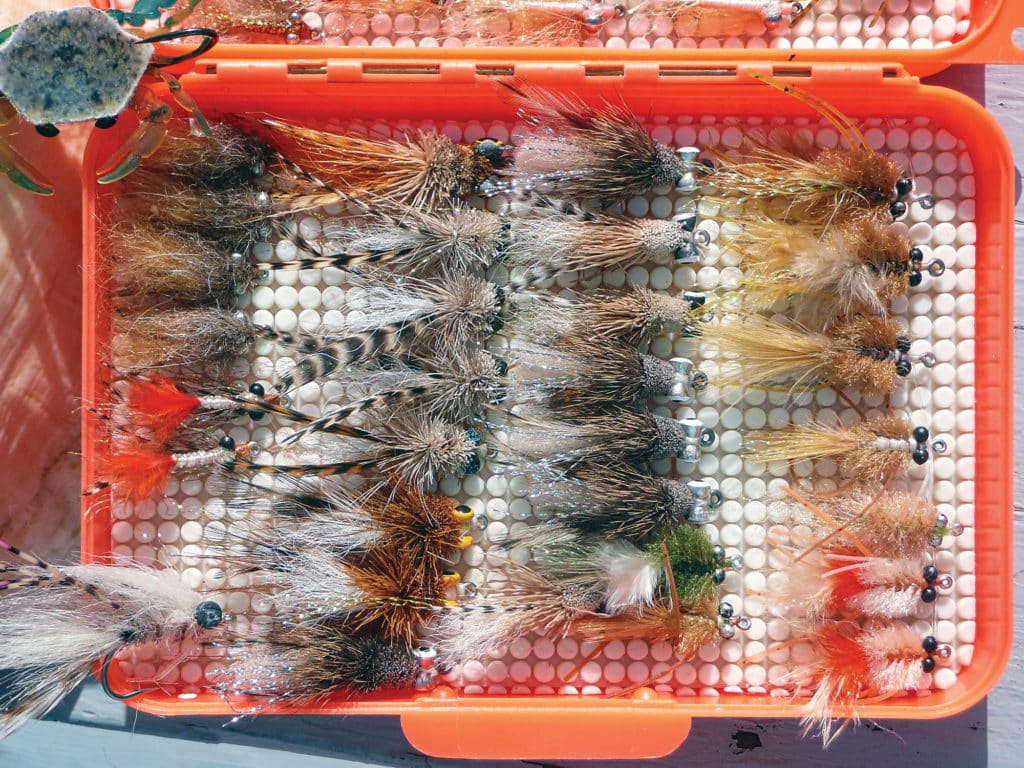
Lines: Floating 7- or 8-weight bonefish taper lines for bones; 9-weight saltwater or tarpon taper (bring floating and clear sink-tip to cover a variety of situations) for tarpon, snook, and permit. You’ll need a 10- or 11-weight fast sinking line or shooting head for big river tarpon. Opt for subdued colors fish won’t detect easily.
Leaders: 9-foot, with 8- or 10-pound tippet for bonefish — increase to 10- or 11-foot when fish are skittish; 10-foot with 16-pound tippet for snook and small tarpon with floating lines — shorten to 7- or 8-foot for casting into tight spots or when using clear sink-tip lines; 10-foot with 20-pound tippet for larger tarpon with floating lines — 6-foot with fast-sinking lines or shooting heads. Add a trace of 30-pound fluorocarbon for snook and small tarpon, and 60-pound for large tarpon.
Flies: For bonefish, Dorsey Kwan, Borski Swimming Shrimp, Gotcha, Beck’s Sili Legs, Bonefish Scampi, and other proven patterns in tan, light brown and pearl — some with bead-chain or lead eyes and others lightweight and sparse — sizes 4 and 6. For tarpon, split-wing streamers, bunnies, and toads, 1/0 and 2/0, in chartreuse, yellow-and-red, black-and-red, purple-and-black, and tan-and-bown, plus a few 3/0 Whistlers for large river fish. For snook, most tarpon flies are fine, but add a few 2/0 deceivers, deer-hair sliders and foam poppers for good measure. Bring Merkins, Ragin’ Cravens, and other tan and light brown crab patterns in sizes 2 and 1 for permit and mutton snapper.









